
Some textiles are more flammable than others. Here is some information to help you choose the safest alternatives.
All textiles can burn, but their properties are extremely different. For example, did you know that you should never wear acrylic clothing near a bonfire?
What you should know before you light a bonfire.
If you're buying clothing for children, you should pay particular attention to the product’s flammability. Ask the sales personnel or check the label yourself.
The structure of the material makes a difference to how it burns. Thin, lightweight textiles that provide plenty of air catch fire and burn quickly. Materials that have a woolly, coarse or porous surface are more flammable than materials with a smooth, impermeable surface.
It is easier for wide-fitting, billowy clothes to come into contact with flames than tight-fitting clothes. Wide sleeves, floaty dresses and lightweight, trailing scarves are particularly vulnerable. These clothes also burn faster than close-fitting clothes because there is more air available. Remember this when you buy costumes for children.
Clothes may also contain chemicals that are harmful to health and the environment. Erdetfarlig.no tells you which chemicals you should avoid.
Clothes made from wool and modacrylic are the least flammable. It is difficult to set fire to thick woollen clothes, and they burn slowly. Fires in thick and heavy woolly fabrics usually go out by themselves. Modacrylic is regarded as a flame-resistant fibre, because it's difficult to ignite, and it melts and pulls away from the flame.
Cellulose fibres, like cotton, linen and viscose, easily catch fire, and the flames spread rapidly if the textile has not been impregnated with a flame retardant. The thinner the fabric, the more easily it burns. Thin fabrics made from cellulose fibres can actually be compared to paper, which is also cellulose-based.
Polyester and nylon melt rather than catch fire, and pull away from the flame. If these materials catch fire, they burn more slowly than cotton and the flame often goes out by itself. Because polyester and nylon melt, the burns they cause are often deeper, but over a smaller area. If they are combined with other fibres, such as cotton, viscose or wool, then polyester and nylon will burn vigorously. You can tell the composition of a fabric from the clothing label.
Acrylic is the most flammable of all the synthetic fibres. It can be difficult to ignite, but once acrylic catches fire, it burns vigorously. Acrylic fibres melt and drip. This means that if acrylic clothing catches fire, it may cause deep burns.